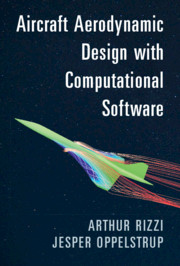Book contents
- Frontmatter
- Contents
- List of Figures
- List of Tables
- Preface
- Acknowledgements
- Abbreviations
- Nomenclature
- 1 Introduction to Aircraft Aerodynamic Design
- 2 Airflow Physics and Mathematical Models
- 3 Concepts and Computational Models in Wing Design
- 4 Finite-Volume Schemes for the Euler Equations
- 5 Airframe Computer-Aided Design and Automated Grid Generation
- 6 Computational Fluid Dynamics for Steady and Unsteady Flows
- 7 Fast Computation of Airfoil Flow
- 8 Airfoil Design Considerations
- 9 Wing Design Considerations
- 10 Configuration Development and Flying Qualities
- 11 Airload–Structure Interactions and Aero–Elastic Effects
- Index
3 - Concepts and Computational Models in Wing Design
Published online by Cambridge University Press: 30 April 2021
- Frontmatter
- Contents
- List of Figures
- List of Tables
- Preface
- Acknowledgements
- Abbreviations
- Nomenclature
- 1 Introduction to Aircraft Aerodynamic Design
- 2 Airflow Physics and Mathematical Models
- 3 Concepts and Computational Models in Wing Design
- 4 Finite-Volume Schemes for the Euler Equations
- 5 Airframe Computer-Aided Design and Automated Grid Generation
- 6 Computational Fluid Dynamics for Steady and Unsteady Flows
- 7 Fast Computation of Airfoil Flow
- 8 Airfoil Design Considerations
- 9 Wing Design Considerations
- 10 Configuration Development and Flying Qualities
- 11 Airload–Structure Interactions and Aero–Elastic Effects
- Index
Summary
The design task facing us is to shape the wing to realize aerodynamic characteristics well suited to the mission. Doing this requires a prediction method of either L1, L2, or L3 genus that maps the given geometry to its pressure field and ultimately to its performance. An early multidisciplinary design and optimization activity is the cycle 1 parametric design of the clean wing, A parametric design study evaluates the aircraft baseline configuration and it has the ability to arbitrarily vary those parameters that influence its shape and hence its performance. It determines the sensitivity of the vehicle effectiveness against some of the established requirements. The parametric effects of, for example, varying the wing planform are assessed, leading toward optimization of the layout by some measure of effectiveness. L0 and L1 tools are enhanced with surrogate models to speed up the aerodynamic evaluations. The vortex lattice method is presented as a mainstay tool in the clean-wing design process and is illustrated using a number of examples. The discussion of the design task continues for high-speed flight missions, indicating where the fidelity must be increased to L2 and L3 tools.
Keywords
Information
- Type
- Chapter
- Information
- Aircraft Aerodynamic Design with Computational Software , pp. 100 - 136Publisher: Cambridge University PressPrint publication year: 2021
